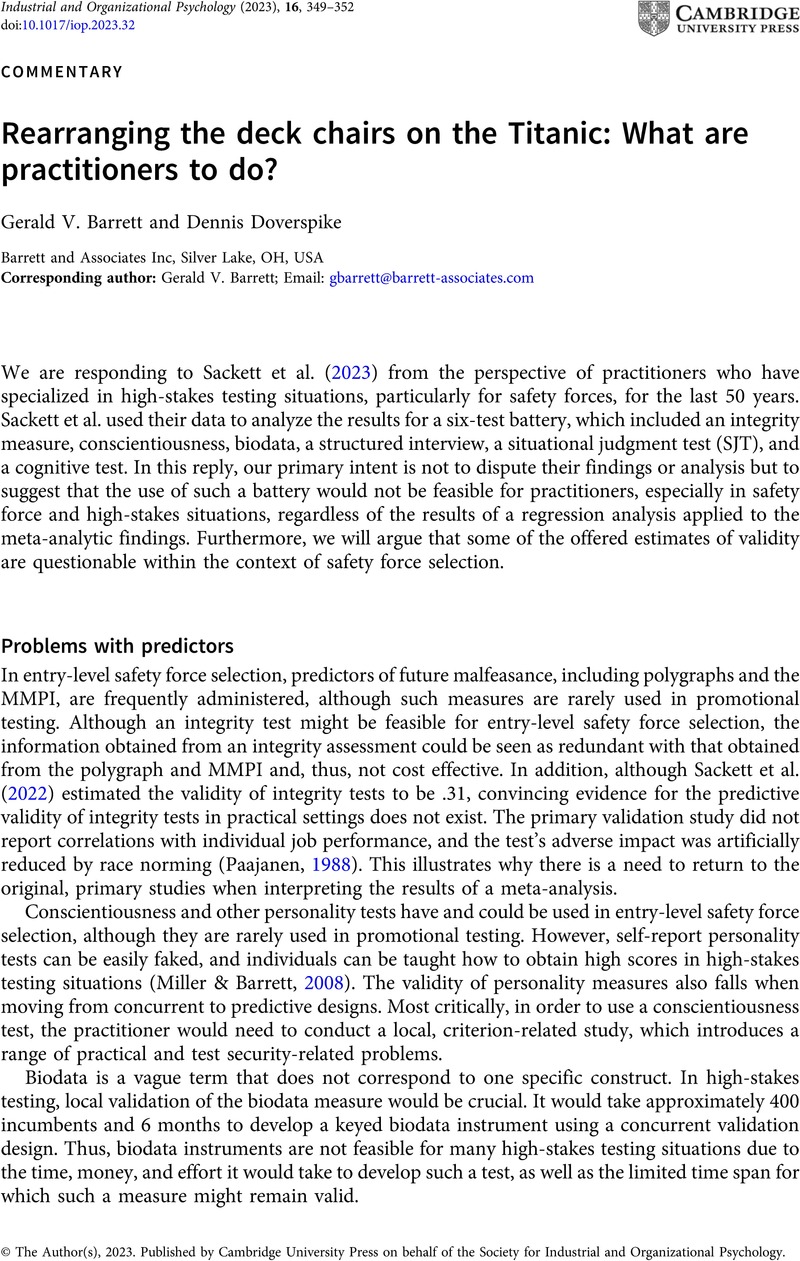No CrossRef data available.
Article contents
Rearranging the deck chairs on the Titanic: What are practitioners to do?
Published online by Cambridge University Press: 31 August 2023
Abstract
An abstract is not available for this content so a preview has been provided. Please use the Get access link above for information on how to access this content.

- Type
- Commentaries
- Information
- Copyright
- © The Author(s), 2023. Published by Cambridge University Press on behalf of the Society for Industrial and Organizational Psychology
References
Arthur, W. Jr., & Villado, A. J. (2008). The importance of distinguishing between constructs and methods when comparing predictors in personnel selection research and practice. Journal of Applied Psychology, 93(2), 435–442. https://doi.org/10.1037/0021-9010.93.2.435.CrossRefGoogle ScholarPubMed
Barrett, G. V. (1972). Research models of the future for industrial and organizational psychology. Personnel Psychology, 25(1), 1–17. https://doi.org/10.1111/j.1744-6570.1972.tb01086.x
CrossRefGoogle Scholar
Barrett, G. V., & Bishop, N. B. (2000). Report on the firefighter selection process and on the development and validation of the Firefighter Personal Preference Inventory (Report prepared for the City of Columbus). Barrett & Associates, Inc.Google Scholar
Barrett, G. V., Polomsky, M. D., & McDaniel, M. A. (1999). Selection tests for firefighters: A comprehensive review and meta-analysis. Journal of Business and Psychology, 13(4), 507–513. https://doi.org/https://doi.org/10.1023/A:1022966820186
CrossRefGoogle Scholar
Millard, K. A. (1952). Is how supervise? An intelligence test? Journal of Applied Psychology, 36(4), 221–224. https://doi.org/10.1037/h0057153
CrossRefGoogle Scholar
Miller, C. E., & Barrett, G. V. (2008). The coachability and fakability of personality-based selection tests used for police selection. Public Personnel Management, 37(3), 339–351. https://doi.org/10.1177/009102600803700306
CrossRefGoogle Scholar
Mount, M. K., & Barrick, M. R. (1995). The big five personality dimensions: Implications for research and practice in human resources management. In Ferris, G. R. (Ed.), Research in personnel and human resources management (Vol. 13, pp. 153–200). JAI Press Inc.Google Scholar
Paajanen, G. E., (1988). The prediction of counterproductive behavior by individual and organizational variables. (Doctoral dissertation, University of Minnesota). Retrieved from https://www.proquest.com/openview/f059fc693a238ec38e3acbebb94594a4/1?pq-origsite=gscholar&cbl=18750&diss=y
Google Scholar
Sackett, P. R., Dahlke, J. A., Shewach, O. R., & Kuncel, N. R. (2017). Effects of predictor weighting methods on incremental validity. Journal of Applied Psychology, 102(10), 1421–1434. https://doi.org/10.1037/apl0000235
CrossRefGoogle ScholarPubMed
Sackett, P. R., Zhang, C., Berry, C. M., & Lievens, F. (2022). Revisiting meta-analytic estimates of validity in personnel selection: Addressing systematic overcorrection for restriction of range. Journal of Applied Psychology, 107
(11), 2040–2068. https://doi.org/10.1037/apl0000994
CrossRefGoogle ScholarPubMed
Sackett, P. R., Zhang, C., Berry, C. M., & Lievens, F. (2023). Revisiting the design of selection systems in light of new findings regarding the validity of widely used predictors. Industrial and Organizational Psychology: Perspectives on Science and Practice, 16(3), 283–300.CrossRefGoogle Scholar
Schmidt, F. L., & Hunter, J. E. (1998). The validity and utility of selection methods in personnel psychology: Practical and theoretical implications of 85 years of research findings. Psychological Bulletin, 124(2), 262–274. https://doi.org/10.1037/0033-2909.124.2.262
CrossRefGoogle Scholar


